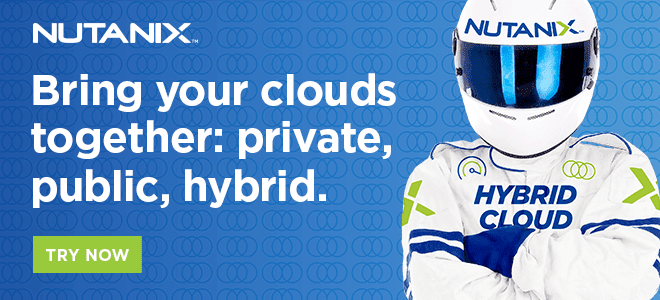When Wendy Pfeiffer, CIO of Nutanix, started with her team on the road to cloud, she realized that interacting with cloud hardware remotely via a universal software utility was a critical enabler of IT efficiency.
“Most applications and workloads were built around the notion of having physical access to infrastructure,” Pfeiffer explained in part 3 of a 10-part Tech Barometer podcast series based on the ebook Charting the Course to Cloud.
“Everything changes once your applications reside in a public cloud vendor’s data center, for the simple reason that you can’t send in your operations personnel to add memory, reconfigure servers, and all the other adjustments that they are accustomed to with their own infrastructure. Instead, you need to be able to interact with cloud systems programmatically, via code.”
This type of architecture reduces operating expenses by simplifying monitoring and maintenance tasks. A relatively small team of IT experts now manages Nutanix’s hybrid cloud environment. Because it all runs on the same foundation, which includes the Nutanix AOS operating system, AHV hypervisor and Prism console.
Pfeiffer can minimize overall IT costs even while scaling information systems to support the company’s growing needs.
“We don’t need so many people configuring physical networks in our data centers,” Pfeiffer said. “In previous IT departments, I had a team of storage engineers and a team of network engineers and a team of backup engineers just to keep the infrastructure up and running. But Nutanix Prism helps us automate. It is intelligently aware of how the operating system uses resources and can proactively help with capacity planning, including moving workloads as needed.”
The architecture improves the IT team’s flexibility: the staff can work remotely yet interact with workloads running in several different data centers and several different clouds. The data center operations team is incredibly lean, with just 6 IT pros responsible for worldwide infrastructure operations in 6 data centers, which supply technology and services to more than 125 locations.
Transcript:
Jason Lopez: If you could operate in any model, whether it's all on-premise or all in the public cloud and so on, what would be the ideal hybrid cloud. The journey to cloud with Nutanix CIO, Wendy Pfeiffer.
Wendy M. Pfeiffer: So I have purpose built something for public cloud. I cannot physically walk up to a server and restarted or add a hard drive or install software directly on that server. Everything I do has to be done remotely and has to be done via software. And then there's this notion in public cloud that there is unlimited resource. I don't have to go install five more servers in the rack next to the current rack in order to get access to resources. I can just ask for additional capacity via software and that capacity will magically quickly be available.
Step three. Our operating system and our hypervisor were not developed in order to sell more of a particular vendor's hardware or to cause people to consume more of a particular vendors, public cloud. We are the only operating system and hypervisor that we're purpose built to create a hybrid cloud everywhere across all of those substrates. We're truly unique in that way. And so this puts tremendous power in the hands of it. What this allows me to do is to create infrastructure that runs the same way, whether it's physical infrastructure on premise and one of my many data centers or whether it's cloud infrastructure in someone's public cloud, ultimately as well, I get huge efficiencies of scale or huge economies of scale in my people. So I run my servers the same way, whether I run them on Dell or HP or Lenovo hardware, or whether I run them in AWS or GCP.
My automation works in all of those environments. My applications work in all of those environments and my storage engineers and network engineers operate the same way in all of those environments. That's an absolute game changer. And so I went from having specialized people for all of these different modes and environments and hardware and infrastructure to having a team of people who are specialized in running hybrid cloud. And quite literally, I have six human beings who run all of the infrastructure across six data centers, large scale global data centers and delivering services to 125 Nutanix locations.
AOS and AHV, unlike the last last decades products they were purpose built for scale out cloud. This operating system was purpose built with the notion that I may never be able to be hands on with hardware. I may be running some of these workloads on premise, but I may be running some of these workloads in public cloud. So I need to run the workload the same way, whether I'm running it on premise or in public cloud, which means everything about accessing system resources and assigning system resources has to be done via code has to be done via software.
However, it's operating inside of a rich ITecosystem. And so because of that, it has to be very dynamic and accessible to it. Folks who might want to have very granular controls over how they manage their use of infrastructure. So the operating system was built in advance with the notion that we may never be able to be hands-on with these resources. And we may have very unpredictable scale and unpredictable requirements. All of those things have to be handled at an operating system level. And as many of those things as possible should be available both autonomously and with the kinds of granular controls that it requires. This is truly the first operating system that was built on purpose with that in mind.
Jason Lopez: Wendy Pfeiffer is the chief information officer of Nutanix. This podcast series of 10 steps to cloud comes from her. E-book Charting the Course to Cloud. This is the Tech Barometer podcast from The Forecast.
Jason Lopez is executive producer of Tech Barometer, the podcast outlet for The Forecast. He’s the founder of Connected Social Media. Previously, he was executive producer at PodTech and a reporter at NPR.
© 2021 Nutanix, Inc. All rights reserved. For additional legal information, please go here.















